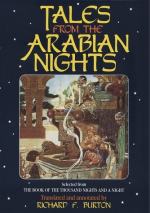The success of Galland’s work led to the appearance of numerous works more or less resembling it, chiefly in England and France. Similar imitations, though now less numerous, have continued to appear down to the present day.
The most important of the older works of this class were published in French in the “Cabinet des Fees” (Amsterdam and Geneva, 1785-1793; 41 vols.); in English in “Tales of the East: comprising the most popular Romances of Oriental origin, and the best imitations by European authors, with new translations and additional tales never before published, to which is prefixed an introductory dissertation, containing an account of each work and of its author or translator. By Henry Weber, Esq.” (Edinburgh, 1812, 3 vols.); and in German in “Tausand und ein Tag. Morgenlaendische Erzaehlungen aus dem Persisch, Turkisch und Arabisch, nach Petis de la Croix, Galland, Cardonne, Chavis und Cazotte, dem Grafen Caylus, und Anderer. Uebersetzt von F. H. von der Hagen” (Prenzlau, 1827-1837, 11 vols.). In the “Cabinet des Fees” I find a reference to an older collection of tales (partly Oriental) called the “Bibliotheque des Fees et des Genies,” by the Abbe de la Porte, which I have not seen, but which is, in part, incorporated in the “Cabinet.” It formed only 2 vols. 12mo, and was published in 1765.
The examination of these tales is difficult, for they comprise several classes, not always clearly defined:—
1. Satires on The Nights themselves (e.g. the
Tales of the
Count of Hamilton).
2. Satires in an Oriental garb (e.g. Beckford’s
Vathek). 3. Moral tales in an Oriental garb
(e.g. Mrs. Sheridan’s
Nourjahad).
4. Fantastic tales with nothing Oriental about
them but the
name (e.g. Stevenson’s
New Arabian Nights).
5. Imitations pure and simple (e.g. G.
Meredith’s Shaving of
Shagpat).
6. Imitations more or less founded on genuine
Oriental sources
(e.g. the Tales of the
Comte de Caylus).
7. Genuine Oriental Tales (e.g. Mille
et une Jours, translated
by Petis de la Croix).
Most of the tales belonging to Class 7 and some of those belonging to Class 6 have been treated of in previous sections. The remaining tales and imitations will generally need only a very brief notice; sometimes only the title and the indication of the class to which they belong. We will begin with an enumeration of the Oriental contents of the Cabinet des Fees, adding W. i., ii. and iii. to show which are included in Weber’s “Tales of the East":—
7-11. 1001 Nuits (W. 1). 12, 13. Les Aventures
d’Abdalla (W. iii). 14, 15. 1001 Jours (Persian
tales, W. ii.). 16. Histoire de la
Sultane
de Perse et des Visirs. Contes Turcs (Turkish
tales,
W. 3==our 251).
16. Les Voyages de Zulma dans le pays des Fees.
17, 18. Contes de Bidpai. 19. Contes Chinois,
on les Aventures merveilleuses du Mandarin




